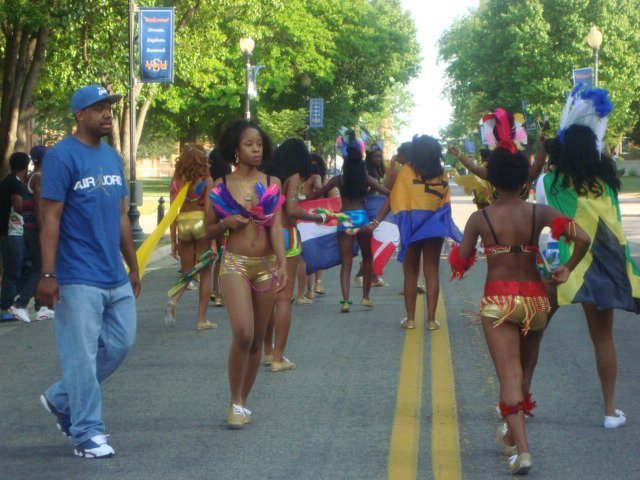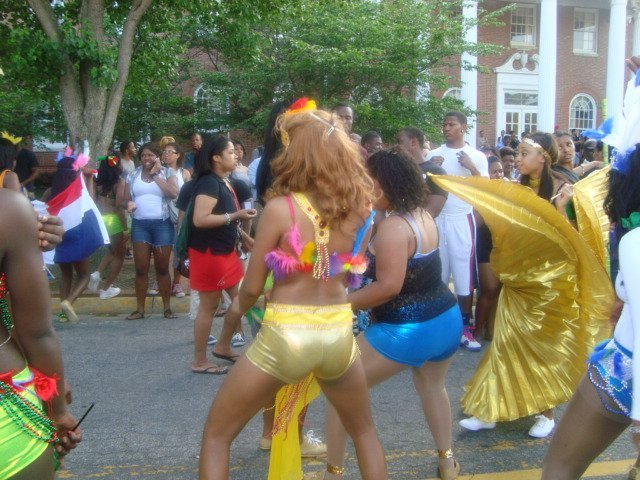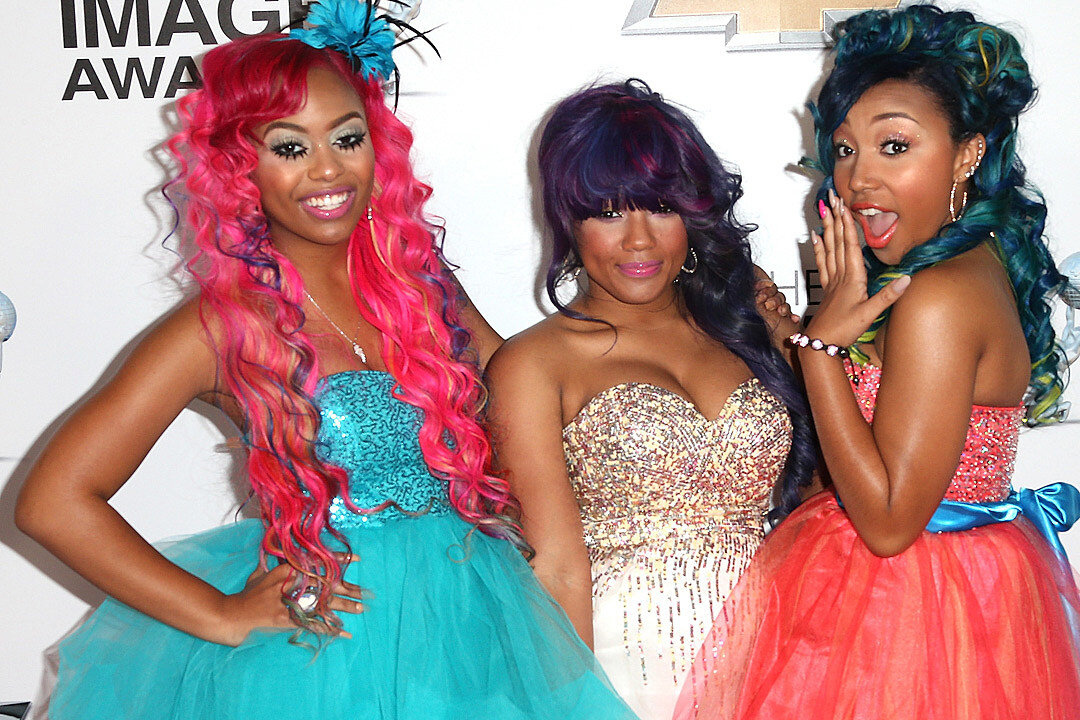by Jessica Wilkins
Soul Train performances from the 1970s and 1980s are some of my greatest sources of joy in this chaotic world, for many reasons. First, the funk and soul music from that era reflect the joy of the Black American cultural experience, fusing gospel, R&B, blues and jazz with drums and syncopated beats that make you want to dance. Second, the music transports me back to the Saturday mornings I spent cleaning the house with my family as a kid. Third, I love the haze of the picture quality and the choreography in all of its theatrical synchronized glory. But most of all I love the fashion in the performances, more specifically the way the men used their costumes onstage to defy rigid gender norms.
Gender-bending through fashion is nothing new. The outfits of women like TLC, MC Lyte, Queen Latifah and Aaliyah immediately come to mind. Baggy pants, oversized t-shirts, bandanas and other garments that were seen as traditionally masculine were sported by women in hip-hop who chose to reject clothing expectations dictated by the feminine-masculine binary. Prior to this, Black male singers like Teddy Pendergrass, The Isley Brothers, The Gap Band, Cameo and The Ohio Players also performed in outfits that defied rigid gender norms. The lapels were huge, the colors were poppin’, the necklines were deep V’s, the pants were fitted and flared, midriffs were out and the boots had heels. There was nary a piece of fabric that wasn’t bedazzled, tasseled, or embellished in some manner.
The reason is because men’s fashion of the 1970s built upon the Peacock Revolution of the 60s, creating space for men to explore a broader definition of masculinity through style. Social changes like second-wave feminism, the Anti-Vietnam and Civil Rights movements, the rise of the Black Panther Party, the first string of gay rights movements and environmentalism, and the ideals and values of the people began to move into a less conservative space. Thus, as did the fashion. Instead of sporting outfits like standard baggy suits in drab colors, men’s style incorporated brighter colors, patterns and textures, longer hair, tall and lean silhouettes and variations on the classic suit.
The lines between traditional men’s and women’s attire were blurred for everyday people. “Fashion had reached a new level of gender equality, particularly in informal wear,” says Milford-Cottam in “Fashion in the 1970s.” José Criales-Unzueta further supports this point in the piece “What Is Queer Fashion, Anyway?,” noting that “this disruption to traditional clothing items or codes of dressing where queerness is often found in fashion, and it can come from various places.”
Male performers took full advantage of the sartorial freedom afforded to them, hitting the stage in costumes that allowed them to shed the confines of traditionally masculine clothing. Not only were their looks an affirmation of their right to dress freely and without restrictions, but the element of performance also affirmed the right of the many viewers and audience members to do so as well. You need to look no further than the current news cycle to see just how important images on television and onstage are when it comes to shaping the opinions of the world around us.
The Gap Band performed “Outstanding” wearing bright red satin matching pants sets that featured glitter embellished collars and sleeves, rhinestone epaulets, and multi-tiered fringe tassels, topped with glitter rimmed cowboy hats.
Harold Melvin and the Bluenotes performed their 1972 single “I Miss You” wearing purple, blue, pink, and orange color-blocked sets that featured deep v-necklines, various cutouts (one that revealed a single nipple), exposed midriffs, and tuxedo tails with white heeled boots.
In the music video for the 1978 disco/house hit “You Make Me Feel (Mighty Real)” Sylvester begins wearing a black leather jacket, black tunic, and black leather pants, with light makeup and textured hair. The next scene features slicked back hair, a white pants suit, and a light green button down shirt accessorized with bangles and a folding hand fan. These looks are modest in their queerness, but by the third and fourth scene, Sylvester transitions into a full multi colored sequined gown accented by a sequined headwrap and finally a gold sequined look with tightly curled hair and makeup. This openly queer icon’s attire reflected more traditionally feminine wear as the song continued. The more real the object of the song made him feel, the more femme his attire became.
As we moved into the early part of the Reagan Era, the age of excess brought forth power suits with exaggerated shoulder pads, athletic wear as outerwear, preppy fashion inspired by the Ivy League, and goth fashion. Androgyny became a signifier of glam and punk rock, and pop well into the ‘80s. “Both men and women wore clothes inspired by Victorian mourning garb and Bram Stoker’s Dracula and it was not long before this movement took to the streets,” writes Kathryn Hennessy in “Fashion: the ultimate book of costume and style.”
When Prince and his band the Revolution opened for the Rolling Stones in 1981, he emerged wearing bikini briefs, thigh-high boots, and a sheer jacket. He was booed off the stage twice as the crowd yelled racist and homophobic remarks and threw food at the stage. Instead of retreating to the safety of more masculine performance attire and lyrics, when homosexuality was vilified from a push for conservatism during the Reagan era and the AIDS epidemic, Prince leaned harder into blurring the lines between race, gender, sexuality, and musical genres throughout his entire career.
Cameo lead singer Larry Blackmon wore a bright red codpiece and thigh-high patent leather boots over a spandex bodysuit in the 1986 video for the hit “Candy.”
Conversely, Black women R&B singers like Phylis Hyman and Whitney Houston played up the feminine glam in their performance attire. Hyman was known for her extravagant headpieces which complimented cleavage revealing necklines, padded shoulders, and embellished dresses.
In the late 80s hip-hop street fashion like tracksuits, sneakers, distressed and tapered denim, polo shirts, nylon jackets, and gold chains dominated as the rap genre gained popularity. And when some of the women in the genre desired to be taken seriously as MCs who could hang when the man, the fashion matched that of the men. As David Opie notes:
“Not only did it help set them apart aesthetically, but in the patriarchal world of ’90s hip-hop, it also sent out the message that these artists wanted to be taken as seriously as the men. By shifting the focus away from the artists' bodies, streetwear helped female artists gain recognition for their music alone in a systemically sexist and misogynist industry.”
When contemporary artists like Saucy Santana, Lil Nas X, Kid Cudi, Bad Bunny and Lucky Daye perform in gender nonconforming looks, they are not only carrying on the tradition of queering fashion in music, but they are also reflecting a changing society. Moreover, just as generations past responded to imposed ideals of hyper-conservatism, so do today’s artists. Maybe this time around, where we’re more openly discussing gender and identity, today’s artists can help usher in a new era wherein everyone can decide for themselves who they are and how they present themselves.





















